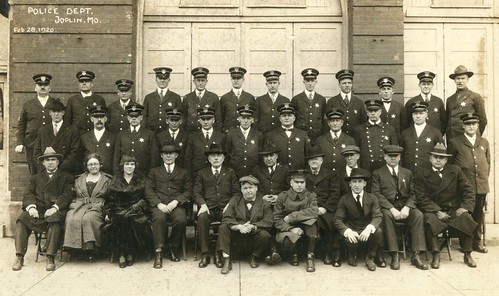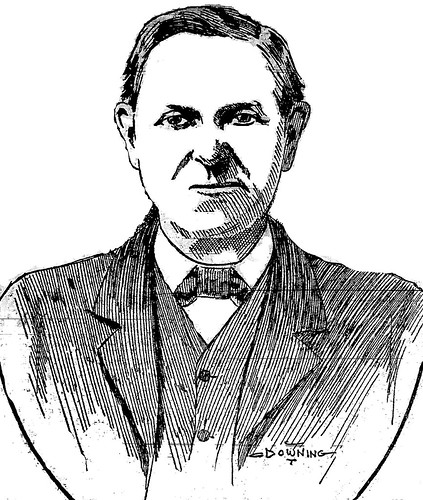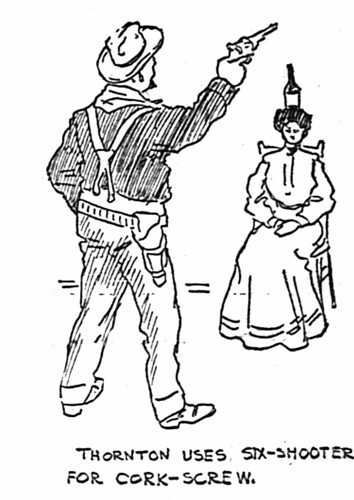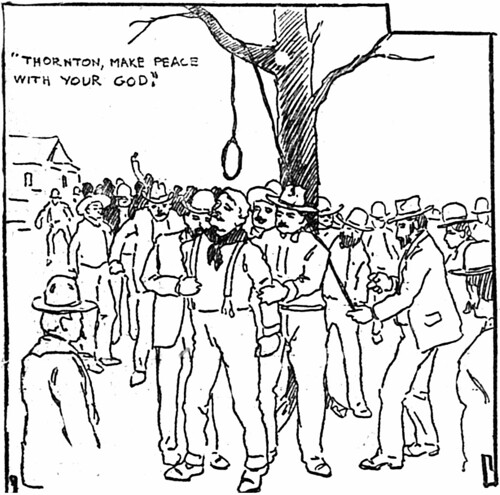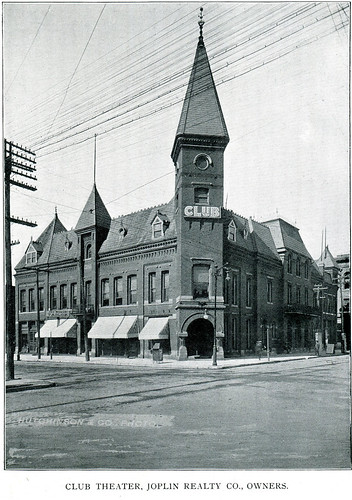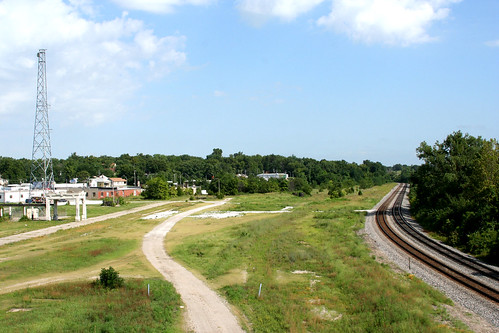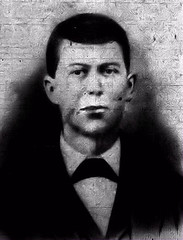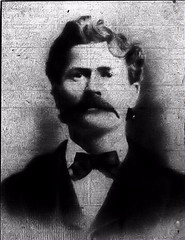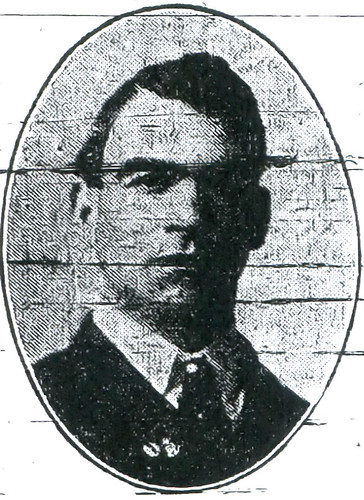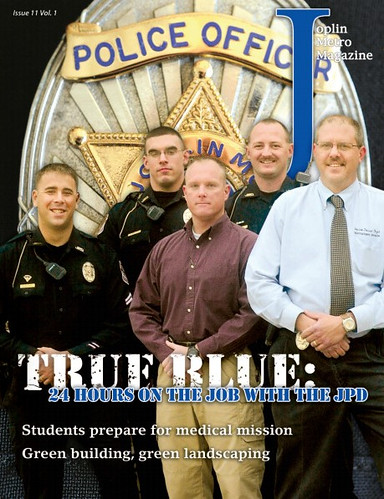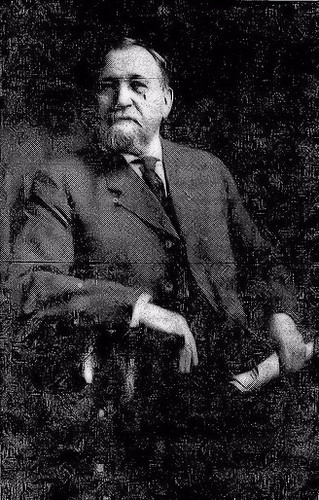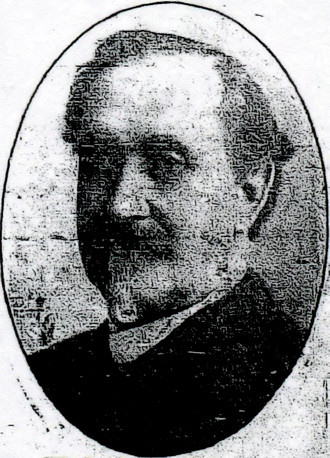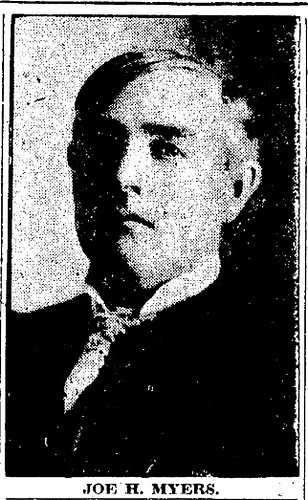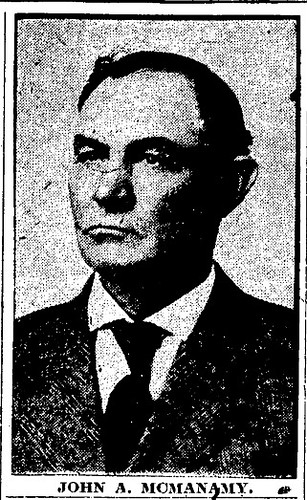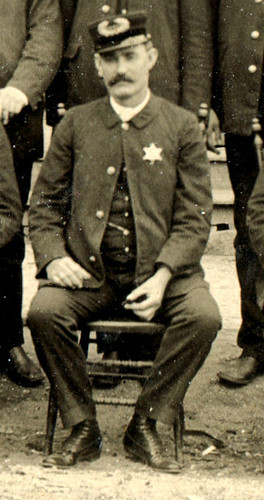Below you will find Joplin’s finest in 1920. The chief at the time was Joseph Myers and the photograph was taken in front of the old city hall. Behind the large doors behind them would have been stored some of the city’s fire engines.
Joplin’s Gallant Irishman: Daniel Sheehan
One journalist described the early days of Joplin as nothing more than, “lead, whisky, and gambling.” He went on to elaborate that it was a time when “the faro table was the best piece of furniture and needed legs like a billiard table to stand up under the coin; when the ‘bad man’ was numerous and had a retinue; when the Indian gave daily street exhibitions or archery, and a shooting gallery was a better business proposition than a skating rink today.”
The citizens of Joplin depended upon a small contingent of law enforcement officials who relied upon their knowledge of the community, their instincts, and brute force when necessary to keep the peace. Among those who walked the muddy streets corralling prostitutes and breaking up drunken fights was Officer Daniel Sheehan.
Born in 1830 in Killarney, County Kerry, Ireland, Sheehan was a “very Irish Irishman” who spoke with the characteristic thick brogue of his home country. He had long served the city of Joplin as a night watchman and police officer. Commonly known as “Dad” to everyone who knew him, Sheehan was said to be “inoffensive as a child [and] always had a mirthful Hibernian salutation.” Despite his inoffensive manner, he allegedly never overlooked a dog that needed taxing at a time when residents still paid a dog tax.
During bad weather, Sheehan would stop by the offices of the Joplin Daily Herald and sit by the stove to keep warm. The paper’s founder, A.W. Carson, was fond of the old Irishman and the two men became good friends. It was said that “Carson got many a juicy morsel of ‘inside’ information that pleased in print — and much that was never printed.”
Carson made sure the Joplin’s gallant Irishman played a prominent role in the stories that he printed in the Joplin Daily Herald. Several of the stories cast Sheehan in a comical light, but provide insight into his daily duties, many of which would be familiar to a modern day police officer: Fights, rowdy prisoners, domestic violence calls, and careless and imprudent drivers.
Sheehan was once greatly offended when an “unruly prisoner” called him a “damned Dutchman.” The editor of the State Line Herald lightheartedly proclaimed, Sheehan was “the only Irish scholar in Joplin who thoroughly understands the language. He is also remarkably well drilled in English military tactics, and can handle a company of men as well as a West Pointer.”
In 1883, a young boy ran up to Sheehan and reported a fight taking place between four or five women. As Sheehan approached the residence, he heard “wailing [and the] gnashing of teeth.” Forcing the door open, he sprang inside, but found the house empty. Perplexed, Sheehan searched the house and stopped when he found “three pairs of plump legs” sticking out from underneath a bed. The newspaper reporter cheekily remarked: “A less courageous heart would have quailed confronted by such an array of hosiery, but faithful Dan proceeded to march them off” to police court. Other calls were, unfortunately, much more serious.
On another occasion, an individual’s “obnoxious” and “bellicose” behavior led to the Sheehan searching him. The officer confiscated: a billy club, two dirks, a self-cocking revolver, two flasks of whiskey, a bottle of sulphate of zinc, a vial of balsam copaiba, and a “toy India rubber shot-gun.” The veteran officer “is in a dilemma whether to start a gun shop or a drug store.”
Like veteran officers of the era who had to rely on their instincts and experience, Sheehan was often in the right place at the right time. When a “gilly from Arkansaw fired off a pistol in the alley near Botkins livery stable” Sergeant Sheehan was “as usual around and welcomed the artilleryman with open arms as he emerged from Fourth Street.” The Arkansawyer was promptly escorted to police court.
On a fall day, Sheehan arrested a visitor from Cherokee, Kansas, who was driving his buggy too fast through the streets of Joplin. The Kansan had come over from “his persecuted state for a little recreation on free soil, and very naturally tarried too long at the bowl wand was soon under the influence of ‘corn juice.’” He decided to hop in his buggy for a jaunt down Main Street. He had almost completed his circuit through town when Sheehan arrested him. The newspaper noted that while the man’s lodging cost him nothing, the city received a fine of $16.25 from him.
On other occasions, he found himself taking care of domestic matters: In the spring of 1881, Sheehan shot and killed a rabid dog on Pearl Street that had attempted to attack a family, and on another call, he arrested a man for beating his wife.
The Irishman spent much of his time arresting Joplin’s sirens of sin as this story illustrates:
“The affable gallant Sergeant Sheehan created quite a sensation yesterday in back alley circles of society by escorting a flashily dressed woman along the somewhat contracted thoroughfare lying immediately west of Main Street,. The old veteran had far more opportunity to show his gallantry on this many scented alley than on Main Street. There were ash-heaps to circumnavigate, slop barrels to evade, and a devious way to as to be threated amongst beer bottles, empty oyster cans, and cast-away cat corpses that strew that delectable Golgotha. The Chesterfield of the force performed this difficult act of courtesy in the most satisfactory manner, although his handsome charge seemed faint and leaned heavily on his strong arm. At one or two difficult passages she even pressed heavily on his larboard quarter is as the wont of the gushing miss in her first overpowering attack of puppy love. The veteran officer was marble and evinced none of the weaknesses of frail flesh and blood. With the placid face of devotion to duty he made the passage and ushered his charge, silk-dress, perfumery, six button kids, and all, into the cooler. It was California Kate on her regular drunk.”
Many of the women were under the influence of drugs and alcohol. On a fall day, he “encountered a lewd woman in a beastly state of intoxication in the alley west of Main Street yesterday. She resisted arrested, fought, scratched, and shouted foul epithets known only to her ilk. In her struggle, she tore off the skirt of her dress, but was finally landed in the calaboose.”
Woe to any lawbreaker who angered the old copper after Pat Wynne of Columbus, Kansas, presented Sheehan with a “new official cane. It is of the substantial order of architecture and will be found of full regulation weight when it comes in contact with an obstreperous law breaker.” Sheehan may have well been carrying this cane when, in 1885, he made his final collar.
Over the years, the city newspapers carried varying accounts of what happened on that hot July afternoon in Joplin. The details, provided by eyewitnesses, fellow officers, and citizens who remembered the tragic events, have been gathered here and distilled into a narrative account that provides the reader with an overview of the events of that day, choosing to instead focus on his life, rather than his untimely death.
In the summer of 1884, Joe Thornton began selling whisky in a two room building that sat on the state line of Missouri and Kansas. Because it was illegal to sell liquor in Kansas, he reportedly sold his illicit liquor on the Missouri side of the line, and because gambling was prohibited in Missouri, he set up gaming tables on the Kansas side of his establishment to the annoyance of local officers.
Although he engaged in nefarious activities, Thornton had allegedly never killed anyone, though he had tried. Thornton had once stuck a .45 pistol into the stomach of Lewis Cass Hamilton, one of Joplin’s toughest law enforcement officers, and pulled the trigger twice. The gun fortunately misfired.
On the fateful day of July 18, 1885, Thornton was wanted on five warrants, and although officers had tried to arrest him for months, he had eluded capture. He generally only left his building once a day at noon to get water. Previously, officers had asked a nearby home owner, A.B. Carlin, if they could hide in his blackberry patch and ambush Thornton. Carlin gave his permission, but later changed his mind, fearing that Thornton would take revenge if the officers failed to arrest him. Thornton, unafraid, occasionally visited Joplin on business.
On July 18, 1885, Jasper County Julius C. Miller stepped out of the Joplin post office on the northeast corner at Second and Main and saw Deputy City Marshal Daniel Sheehan standing on the opposite corner. Sheehan alerted Miller that Thornton was in town and said if Miller wanted to arrest him, Sheehan and “Big George” McMurtry would help.
Miller was in a difficult position. He knew that Joplin City Marshal Cass Hamilton had ordered Sheehan to never attempt to apprehend Thornton because Thornton had threatened to kill Sheehan, claiming the old Irishman had once mistreated him. Miller, Sheehan, and McMurtry met at the northwest corner of Second and Main to discuss the matter. Sheehan was insistent that they arrest Thornton and added, “an’ sure all we’s have to do is kape him from gettin’ to his weapon.” The men noticed Thornton’s buggy tied up outside of Simon Schwartz’s dry goods store, Famous 144. The three officers headed toward to the store. Once inside, Sheehan pointed Thornton out to Miller, who had never seen Thornton before. Miller began advancing toward Thornton who had his back turned to the door. Miller tapped him on the shoulder and asked if he was Thornton. Thornton replied that he was. When notified that Miller had a warrant for his arrest, Thornton remained calm, but when Miller said, “Sheehan, take hold of his other arm,” Thornton pulled out his gun and shot Sheehan.
Miller, who was described as six foot tall and “no invalid,” jumped on Thornton and tried to wrestle the gun away from him. Unfortunately, Miller’s hands were near Thornton’s mouth, and bootlegger began savagely biting Miller’s fingers and wrists. Miller could “feel the membrane begin torn from the bone” by Thornton. One of his hands was caught up in the action of the gun and Thornton kept “snapping away and every fall of the hammer was cutting into shreds the skin and flesh between Miller’s thumb and forefinger.” Miller’s tattered hand was the only thing keeping the gun from firing. As one account put it, “Miller had to stand it or leave a widow at home.”
Sheehan, who had been caught up in the fight, realized he had been shot. He cried out, “Oh, I’m shot! Take me out! Take me out!” before he fell to the floor. Deputy City Marshal McMurtry was ordered by Miller to “do something and do it quick. He’s eating me up.” Sheehan, lying helplessly nearby, called out, “Take my club!” McMurtry grabbed the Irishman’s club and began beating Thornton as hard as he could over the head, but accidentally hit Miller with the second blow. Miller yelped, “Don’t kill me, Mac!”
Contractor Sol Wallace and coal dealer W.E. Johnson rushed into the fray and pulled the store’s twin merchandise counters apart so that they more easily help separate the two men. McMurtry continued to strike Thornton in the head which was a bloodied mess. Thornton bit Wallace, but Wallace managed to get a grip on the pistol. When Thornton would not let go, Wallace kicked him in the throat, but the blow did not seem to register. Finally, his adrenaline exhausted, Thornton surrendered.
The four men started Thornton to the door on the way to the jail and were followed by a weakened Daniel Sheehan. The Irishman collapsed in the doorway and was taken to Dr. Kelso’s office. An examination showed that the bullet had entered a little below to the left of the navel and ranged downward and presumably lodged in tissue near Sheehan’s spine. When it became clear that Sheehan had but a short time to live, he was taken to his home. Miller’s hands and wrists were “in ribbons” and he carried the scars of his encounter with Thornton for the rest of his life.
After Thornton was put in jail, a crowd gathered, trying to catch a glimpse of the man who had shot Daniel Sheehan. He talked freely, telling one questioner that he was raised in Parkersburg, West Virginia, and that “I am too lazy to work and too ornery to live. If you want to send me over the road, I’m ready.” When someone mentioned lynching, Thornton reportedly replied, “I deserve to die and if they will bring on the rope, I’ll march out and die game. I don’t want to be mutilated and abused. I’d rather die now than go to the pen.”
News of the shooting spread quickly and a mob began to gather. Shouts of “Hang him!” and “Joe Thornton must die!” could be heard on the streets of Joplin. At two o’clock in the morning, a group of men approached the city jail with a battering ram. With just a few blows, the door was forced open, and the men found Thornton sitting in the first cell. The mob threw a rope over his head and marched to the “Kennedy property” at Second and Main where there were several maple trees. A crowd gathered to watch, but the mob kept the curious onlookers from getting close until they had lynched Thornton. Only then could spectators approach and look at Thornton’s body. He was pronounced dead and the coroner declared he had died at the hands of parties unknown. The Joplin Daily Herald remarked, “Thornton has paid the penalty of crime with his life. A dozen such lives would be feeble atonement for his crimes. Mob law is to be deplored, but great emergencies require desperate remedies.”
Thornton’s mistress, May Ulery, arrived to claim his body. She dressed him in a new suit of clothes before a hearse from Galena arrived to transport his corpse to the residence of his brother in Galena. Thornton was then buried in the Galena City Cemetery. A few weeks later, the building that housed Thornton’s dive was moved from the state line to Galena, Kansas.
Daniel Sheehan died a short time later on July 19, 1885. The fifty-five year old Irishman left behind a widow, Kate, and five children at home, including the youngest, Cecilia, who was one. His family received a free plot from the city in Fairview Cemetery for his burial. The vacancy on the police force was not filled for a month after his death so that his family could receive a full month’s salary by the “kindly arrangement of his brother officers.” Fellow officer McMurtry kept the shell casing from the round that killed Sheehan. The remaining five shells were removed from pistol, a .38 Colt, and distributed as mementos.
The citizens of Joplin were grateful for Sheehan’s service. A subscription fund was started by Joplin Daily Herald editor A.W. Carson to pay for a handsome stone monument from True Brothers & Sansom. Among the more prominent names on the list were Thomas Connor (.50 cents), Thomas W. Cunningham ($1.00), Clark Claycroft (.25 cents), Charles Schifferdecker ($2.00), W.H. Picher ($1.00), and Edward Zelleken ($1.00). Fellow officer Lewis Cass Hamilton gave the most money with a $5.00 donation and Simon Schwartz, owner of the store where Sheehan was killed, donated $3.00.
The handsome marble monument still stands as a testament to an immigrant who made a new life for himself in the rough and tumble mining town of the old Southwest.
Proud to Visit Joplin’s Jail
In early Joplin, there was no shortage of Joplinites who were escorted to the city’s hoosegow. Surprisingly, some of these individuals were quite proud of their predicament. A Joplin Globe reporter interviewed Joplin Constable Arch McDonald about the phenomenon,
“You may not believe that it actually makes some people proud to be arrested. There’s all the difference in the world the way various people take the situation when the officer is compelled to duty. Some men readily appreciate the officer’s difficulties and prepare to go right along just like attending to any other business engagement; while others blame the officer who is called upon to serve the warrant and think its his fault, much the same as some people hold it against the postman when they fail to get a letter.”
Another Joplin police officer, Will Gibson, offered his own experience,
“Proud? Why yes, it’s the event of some fellows’ lives to get arrested, and some of them think it a real honor to be shown the distinction of being singled out of a crowd and marched down the street to jail. I arrested a young miner from Chitwood the other night for being drunk and disorderly on Main Street between Fourth and Fifth, and he didn’t seem half so drunk after I took hold of him. He wasn’t scared sober, either, but was just swelled up over having the strong arm of the law take notice of his antics, I guess. He braced up at once and told me that was all right, that he could walk straight, and then stepped off down Main street like a ham-strung thoroughbred, looking first to the right, then to the left, and making it a point to say something to every acquaintance he saw. He was plainly the cock of the walk.”
Deputy Sheriff Clarence Kier had this for the reporter,
“Nor are the drunks the only ones who feel the honor of being taken into custody. I’ve seen men arrested for some petty offenses of a more or less serious nature who got right chesty over it and swaggered down the street. One man in particular from over in East Joplin put the thing plainly when I started for the car line with him and his wife called to know where he was going. ‘Can’t you see,’ responded the fellow with a sort of self-important air,’ that I’m being arrested!”
Finally, United States Deputy Marshall, Henry Platt, offered his own experience,
“There’s another phase to the seeming willingness of some men to go along with the officer. I’ve seen federal prisoners puff all up when thrown into jail, and hold themselves aloof from common state felons and petty criminals, but that isn’t the secret of it. You’ll find that it isn’t only the novice nor the best citizen who goes along willingly with the officer, but that the very worst criminal of all is a good dissembler and very frequently scores a point by the apparent acquiescence and good nature with which he submits to arrest. The quiet man is often worse because he is shrewdest and most slippery of all evil doers.
He is not the murderer nor the criminal of passion, but the criminal of property, the thief, the forger, the embezzler, the counterfeiter, the one who works along original and stealthy lines. He’s just smart enough to know when he’s cornered, and if he sees that the chances for escape are all against him he quietly submits and goes along with the hope of affecting escape later, or by getting the minimum penalty by arousing the least suspicion. When the time comes for his break for liberty, the seemingly well behaved and tractable prisoner shows himself to be the most desperate of the bunch. He’s the criminal exemplification of the man with the ax to grind.”
An interesting aside to be picked up from the answer is the fact that Joplin police would use the trolley line to take prisoners back to the city jail. The equivalent today having a police officer get on a city bus with a prisoner in handcuffs.
Kansas City Bottoms: Part II
As time passed and mining operations relocated across the area, the Kansas City Bottoms was transformed as “a few factories and mills” dotted the valley and its hillsides. Although there was talk that the Kansas City Southern Railway would build rail shops in the bottoms, the project never came to fruition.
This led to an effort to “more or less isolate the city’s riff-raff of humanity there. It became a sort of ‘red-light’ district, and flourished with gayety, containing gambling houses, saloons, dance halls, and rooming houses.” As Joplin continued to grow, the area grew more desolate, and “buildings were moved, burned, or fell in ruins.” The Kansas City Bottoms soon became a sprawling slum that doubled as a dumping ground. At the turn of the century, an angry mob descended upon the Bottoms and chased out a number of prostitutes who had taken up residence there. Soon the area became populated with African Americans, some of whom had been chased out of Pierce City in 1901, after a brutal race riot ended in the expulsion of Pierce City’s black residents.
A lifelong Joplin resident shared her memories of the Bottoms in a letter to the Joplin Globe:
“Where the [Union Depot] station is now and scattered throughout the valley were shanties occupied mostly by colored folk. This place was known as the Kansas City Bottoms. There was a footbridge over Joplin Creek near where the Union Station is now. Rather than walk around to Broadway, for four years I walked through the Bottoms and came onto Main Street at about A Street on my way to high school.”
“A girl or woman did not dare to cross the Bottoms without an escort. It was not even safe for a man,” the woman continued, “My boyfriend who later became my husband lived on the West side and he never crossed without a weapon. There were often holdups and sometimes murder in the Bottoms. There was no Broadway viaduct then.”
One former Joplin police officer claimed that “policemen were virtually given orders ‘not to bring any of the ‘bottomites’ out.’” This reportedly meant that a police officer should “shoot at the least provocation and shoot to kill.”
These reputed orders presumably came after the death of Officers James Sweeney and Bert Brannon in 1901 after they were shot and mortally wounded after arresting a gang of vagrants in the Kansas City Southern rail yard and the death of Officer Theodore Leslie who was killed in 1903 while searching the rail yard for a burglary suspect. In 1909, work began on the Third Street viaduct, which spanned the Bottoms to connect East and West Joplin. (To Learn more about the Third Street Viaduct – click here) A year later, work began on the Joplin Union Depot, and a portion of the Kansas City Bottoms was leveled to make way for the expanded railyards and station. (To learn more about the leveling of the Bottoms for the Depot, click here)
By 1915, the condition of the Kansas City Bottoms was as close to a living hell as one could find in Joplin. One account painted a bleak picture of life in the bottoms: “Squatters, trash and garbage haulers, tramps and other transients” moved into the bottoms, living in shacks, shanties, broken down wagons, and tents. Men, women, and children lived in abject poverty. Few outsiders dared enter the bottoms as it had a reputation as, “a most dangerous place. It hardly was safe for a person to enter in daylight. After dark, entry into the hollow by an outsider was practically synonymous with suicide.”
That same year, however, the Kansas City Bottoms would experience a significant transformation for the first time since Sergeant first struck lead.
Death Escaped, But Not Avoided
On a May day in 1910, Joplin nearly lost a councilman. Jesse Laster, not a stranger to the zinc and lead fields of Southwest Missouri, listed zinc mining as his profession in the 1910 Federal Census. It was that same year that Laster had been elected on the Democratic ticket to represent the Seventh Ward of Joplin. A father to three, later to add one more son to the son and two daughters he already had, Laster had ventured out with a mine superintendent, Harry Williams, to a mine in Duenweg.
The afternoon sun high above, the 28 year old councilman and Williams made the decision to board a tub to descend to the mine 200 feet below. Both had years of mining experience and undoubtedly the act of being lowered in the metal container into the dark depths of the mine shaft was a familiar one. Inside the tub, one or both of the men likely signaled the mine’s hoisterman to lower them down.
The hoisterman was new at his job and the equipment purported to be in good shape. However, as the tub with the councilman and the superintendent began to lower, the hoisterman released the brake and to his horror, watched the tub with the two men plummet to the bottom of the shaft. Nothing the hoisterman did slowed or stopped the tumbling tub. In a sickening sight and loud crash, it smashed into a bucket full of dirt. Laster and Williams were thrown out and into an adjacent drift, both men knocked unconscious.
It was not uncommon for miners to die in such accidents, but both Laster and Williams survived that day. When astonished and fearful miners reached the men, they found Williams with severe wounds to the head and a broken arm. The councilman suffered a cut to the face, an injured shoulder, and a broken right femur. Williams was taken to his home to recover, Laster was rushed to St. John’s hospital. At the time of the reporting of the incident, it was believed both men would recover. Laster did, though only to live for another sixteen years.
The dark eyed and dark haired councilman, perhaps wary of the mining profession, had by 1918 joined the Joplin Police force and achieved the rank of detective. By 1926, Laster had been promoted and wore the title Chief of Detectives. On a hot August evening, the chief with his family were heading home when Laster spotted an armed man by the side of the road. Unknown to the former councilman, the man was engaged in bootlegging and mistakenly believed Laster and his family to be rival bootleggers. When Laster identified himself, the man shot and killed the 46 year old father of four. Laster was the tenth Joplin police officer to fall in the line of duty.
Sources: 1910 Federal Census, 1920 Federal Census, Joplin Police Department website, and Joplin Daily Globe.
Joplin History in Volume 1, Issue 11
In the most recent issue of the Joplin Metro Magazine, Issue 11, the pickings are regrettably slim for pieces of Joplin history. The lengthy article on the Joplin Police Department has some information on the history of the department, including a list of officers who have fallen in the line of duty. The murder of one officer on the list, Officer Theodore Leslie, sparked the lynching of Thomas Gilyard. For more details on that murder and the lynching, pick up a copy of White Man’s Heaven, by Kimberly Harper. You can learn more about the Joplin Police Department on Historic Joplin here. Copies of the Joplin Metro Magazine can be found around Joplin in businesses, including the lobby of the Joplin Globe building.
What Did You Do During the War, Grandma?
During the height of World War One, a covert raid was launched by the Joplin Police Department on behalf of the federal government. Chief of Police Joseph H. Myers, Assistant Chief of Police Charles McManamy, Chief of Detectives William F. Gibson, and an assortment of “street sergeants” met under the cover of night at the police station. Few, if any, of their colleagues knew about the raid. Chief Myers was concerned some of his men might tip off the intended targets.
At eleven o’clock at night, the men set out in squads. Their orders: to raid all rooming houses on Main Street and arrest all female occupants. In a complete surprise, the chief and his men successfully carried off the raid. One hundred and forty two women were taken into custody and taken to the Joplin Police Department. Once there, they were examined by “city physicians under the direction of Dr. R.B. Tyler,” Joplin’s commissioner of health and sanitation. Those assisting Tyler were Drs. W.H. Lanyon, J.B. Williams, D. R. Hill, and R.W. Amos. Of that number, fifty five women were detained on suspicion of having a venereal disease. They were to be held for observation and would be released only after they showed no signs of a sexually transmitted disease.
After the raid and subsequent examinations, Dr. Tyler told a reporter that “Joplin is unusually clean. Few of the girls detained will be required to remain in the detention home.” He estimated that at least ten percent of the women arrested were afflicted with venereal disease. Curiously, as the sun rose in the sky over Joplin, eight women voluntarily surrendered themselves at the police department for examination.
For those fortunate enough to escape detention, they were brought before Judge John McManamy and charged with “improper conduct.” Apparently many, if not all of the women, pled guilty and paid a $10 fine. They were then released on “parole” with the understanding that they were to report weekly to Chief Myers or to Desk Sergeants Dave Isbell or Verna P. Hine. The women would have to report their current address and whether or not they had been “working.”
Police Matron Wathena B. Hamilton and Assistant Matron Minnalin McKenna were to assist women find gainful employment if requested.
Shockingly, it was reported:
“Investigations conducted by the police at the instance of officials of the war department resulted in the obtaining of approximately twenty names of wives of soldiers and sailors in government service, either in Europe or in American cantonments. Should they be found to be of questionable character, reports will be made to the proper officials and their allotments stopped, if their husbands request it.”
Talk about government intrusion!
Joplin City Marshal Explains Suicides in Joplin
In 1904, Joplin City Marshal John A. McManamy gave an interview regarding suicide cases in Joplin. In it, one can observe strains of gender, class, race, and economics that provides insight into the suicidal trends of the city.
McManamy claimed that the majority of would-be suicides in Joplin were women, often “women who have fallen from the highest plane of moral standing. As a rule they are not successful. But as a rule also, this class of women, if they fail the first time, they try it again.” Very few African-Americans in Joplin attempted suicide, McManamy claimed, as “it is the rarest sort of thing that a negro ever wishes to end his own life and it is more rare still that they ever attempt to end it. Negro men are not the least prone to commit suicide and negro women seldom bother us in this manner.
According to the marshal, most suicide cases involved the use of carbolic acid, which caused an individual to “suffer the greatest of agonies before they finally shuffle. In the event they do not take enough of the poison to produce death, the suffering they undergo while recovering is fearful.”
Others chose to use morphine and cocaine. If the police found a morphine user before death claimed them, the officers would treat them for morphine poisoning by “pounding the party with wet towels, by rapping him hard knocks on the body, by rubbing the legs until they almost blister and in fact indulge in almost every kind of heroic treatment that will keep the would-be suicide awake, until the antidotes have time to neutralize the morphine.” McManamy noted that cocaine and arsenic suicide attempts also required “heroic treatment” as the would-be victim would often go into spasms while yelling, groaning, or crying. He disapproved of what he called “gun play,” but unhelpfully pointed out that cutting one’s wrists was the most effective way to end one’s life.
When asked what caused many of the would-be suicides in Joplin, McManamy declared, “Suicides usually follow debauches, or financial reverses. Debauches with the women and financial reverses with the men. These debauches may be brought about by many causes, disappointments in love being the most frequent.”
For the benefit of the paper’s readers, the marshal sternly pointed out “An attempt at suicide is poor business. Not over ten per cent of the attempts that are made are successful. The agonies, the sufferings, the tortures of the period following the attempt, with those who are not successful, make the game not worth the candle. Life may not hold out any hope to the would-be suicide, but there is seldom a life so devoid of hope, or so without light, that it is not better than the life of one who is frustrated in an effort to end all with one fell swoop.”
Source: Joplin News Herald
If you ever find yourself in need of help or in a time of crisis and need someone to talk to:
http://www.suicidepreventionlifeline.org/
http://www.save.org/
http://www.afsp.org/
